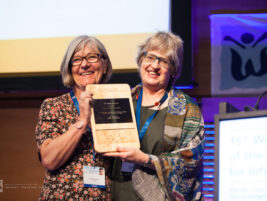I enjoyed reading Mr. Rygaard’s reflections on changing infant environments. He deals with a very important topic and has raised equally important questions. I totally agree that research needs to catch up with the rapid changes in the settings where infants grow up. We have to re-think our child development theories and test whether they still apply to the reality and world today.
I like the quote that Mr. Rygaard is referring to: “It takes a village to raise a child,” an expression that is commonly attributed to African origins. It holds so much truth for times when relatives care for the child and also for times when parents share the responsibility for care with others. In this sense the quote is still true even for the changing infant environments.
Childcare in Urban Environments
When we try to apply certain developmental theories to the changing urban environments we may struggle. Children with different caregivers (e.g. mother, father, nursery school teacher, day nannies) can show different attachment styles depending on the caregiver. So it is difficult to put each child into one category of attachment style. The behavioral researcher and anthropologist/ primatologist, Sarah Blaffer Hrdy (2001) suggested that the attachment quality between mother and child may not be solely important for the development of the child, but, rather, the overall quality of the relationships with all caregivers.
In human history, children were always taken care of by caregivers other than their mothers. Often the close social network (e.g. the family and neighbors) took care of the children. These attachment figures remained part of the child’s social network for a long time, so that stable bonds could grow. Today, childcare often takes place outside of the close social network in a more professional setting like kindergarten or nurseries. The kindergarten or nursery can be a part of the social network if the quality of care is good (Andersson, 2003). Studies describe high quality care as: a reliable caregiver, who is sensitive and competent and meets the needs of the child (Ahnert & Lamb, 2004). A problem arises if the caregivers in childcare institutions are not consistently present and may often change. This is a problem we also know from research on institutional care for orphans and children without family support (Hermenau, Hecker, Elbert, & Ruf-Leuschner, 2014; McCall, 2013), even though the situation and state of children in institutional care is of course not equivalent to children in childcare.
While the quality of childcare in Germany is not as high as in Sweden, for example, Germany tries to improve the care concepts in order to react to the changing infant environments and higher rates of children in childcare. Parents with small children may choose a day nanny who takes care of a few children rather than a nursery where there are many children to care for. Some nurseries and kindergartens adjusted and updated their care giving concepts as well. They provide family-like groups, where children from different ages are mixed together and the groups remain stable until a child leaves the group at school age.
If the quality of day care is high, childcare can provide the child with experiences that are quite good. In former times, age-mixed groups of children were an important part of a child’s social network. Today, the close social network may not include such age-mixed groups . If the child stays at home with the mother most of the time, childcare in age-mixed groups can provide the child with opportunities to interact with other children and to improve social skills (Ahnert & Lamb, 2004; Andersson, 2003).
It would nevertheless be ideal if the children would still spend a substantial part of their time with their parents. If the parents keep a close relationship to the child and find a balance between time in childcare and time with the parents, the child-parent relationship remains stable (Ahnert & Lamb, 2004). However, stressful and uncertain living conditions at home, long hours in day care and low care quality hold potential risks for the children’s development (Andersson, 2003; Hrdy, 2001).
Unfortunately, at least in Germany, findings from research are not very present in public discussions about childcare. The public discussion about the advantages and disadvantages of childcare seems very emotional and lacks scientific support. I can see some parallels to the discussion about whether there should be orphanages or not. However, for both, we can draw one conclusion from research: The quality of care matters more than the setting (Ahnert & Lamb, 2004; McCall, 2013; Andersson, 2003).
Globalization and Changing Environments
As the quote “It takes a village to raise a child” is often attributed to having origins in African cultures, it also makes me think about the developing countries in two different ways: First, theories, like Bowlby’s original Attachment Theory, often develop based mainly on the western middle-class family. Applying theories like these to more collectivist communities and care networks like those in African countries, certain theories and concepts reach their limits. So globalization also challenges our western theories. We need to think again and re-adjust them in response to infants and families around the world.
Second, also in African countries, care responsibilities shift and I am very worried about this. For example in Tanzania, parents are often not aware of the importance of quality childcare. Parents and relatives know that education is important. While providing children with the best education they can afford, they often neglect emotional and psychological needs of their children. As a consequence even three-year-old children are placed in boarding schools (Kibakaya, 2014). In order to be successful in their careers, parents often need to be flexible and work long hours. They may live far from their relatives due to the location of their work. Therefore, they pay the schools to take care of the children and hand the responsibility over to the teachers. Parents expect that schools take not only care of the educational development but also of the moral and social development. Children in Tanzanian boarding schools often live in hostels. In these hostels the caregiver child ratio is even worse than in orphanages. However, the children are not seen to be at risk, because their parents are still alive and they are not suffering from poverty. Parents are not yet aware of their importance for their children’s healthy development.
Through globalization, western concepts and theories may be applied in other countries or cultures without prior testing. If the theories only hold true for western settings, cultures and societies, we will struggle to create environments for infants that work for different cultural backgrounds. We need to critically rethink and test our theories to differentiate where we deal with the universal needs of infants and with cultural differences.
With intercultural and global research we need to address the challenges emerging in other countries with fewer resources. We need to establish concepts of universal infant needs and practices. In a globalized world it is even more important to test scientific findings on their global validity and to make them accessible for all. Using scientific findings in order to improve environments for children should not be a western privilege!
Opportunities in Changing Environments
Besides the challenges that urbanization holds for infant development, I think it is important to acknowledge also the new opportunities that emerge:
Networking between mothers is much easier, by accessing information and sharing via internet and new media. Young mothers can use the available information and decide how to raise their children. They do not have to do it the way their (grand-) mothers did. Young mothers from families where corporal punishment was common can decide that they do not want to spank their children. They can use the Internet to gain knowledge and to learn alternative parenting strategies. They can decide to step away from the corporal punishment that was part of their own childhood. I think this may be easier through the digital access to information from all over the world.
The variety of different childcare models can allow parents more influence on their child’s care. Ideally, parents could choose who takes care of their child. It does not have to be the mother-in-law or the aunt who may have a different opinion about child rearing and might spank the child.
Globalization can also help to spread knowledge and raise awareness of the needs of children. In countries like Tanzania, psychology gets more into focus in politics and public awareness. Thanks to the Internet we are able to support talented and creative psychologists in Tanzania through exchanging knowledge and supporting research. We are able to forward information via email to young parents in Tanzania; we can supervise school counselors via video chat or voice call. This is also part of the change.
Coming back to quality childcare, the Internet and the new media provide us with a great potential to spread evidencebased interventions to improve the living conditions of many children. With programs like fairstartglobal, the program developed by Mr. Rygaard, it is possible to spread knowledge, enable caregivers and improve the life of many children in a globalized world.
In essence, beside all the challenges that urbanization and globalization hold for infant development, they also bring new chances for change and improvement. It is a very interesting time for research! Let’s do not miss this opportunity to keep up with the changes in infant environments!
Katharin Hermenau, Ph.D. is a clinical psychologist and postdoctoral research fellow at the Department of Psychology, University of Konstanz, Germany. Her work focuses on consequences and prevention of child maltreatment in families, foster families and institutional care. As a board member of the NGO vivo international Dr Hermenau supports the implementation of evidence-based interventions in countries with limited access to mental health care.
References
Ahnert, L., & Lamb, M. (2004). Child care and its impact on young children (2–5). In R. E. Tremblay, R. G. Barr, & R. D. Peters (Eds.), Encyclopedia on early childhood development [online] (pp. 1–7). Montreal, Quebec: Centre of Excellence for Early Childhood Development. Retrieved from https:// www.enfant-encyclopedie.com/Pages/ PDF/Ahnert-LambANGxp.pdf
Andersson, B. (2003). Child Care and Its Impact on Children 0 – 2 Years of Age. Commenting: Belsky, Howes, and Owens. In R. E. Tremblay, R. G. Barr, & R. D. Peters (Eds.), Encyclopedia on early childhood development [online] (pp. 1–4). Montreal, Quebec: Centre of Excellence for Early Childhood Development. Retrieved from https:// www.child-encyclopedia.com/sites/ default/files/textes-experts/en/857/ child-care-and-its-impact-on-children- 0-2-years-of-age.-commenting-belskyhowes-and-owen.pdf
Hermenau, K., Hecker, T., Elbert, T., & RufLeuschner, M. (2014). Maltreatment and mental health in institutional care – Comparing early- and lateinstitutionalized children in Tanzania. Infant Mental Health Journal, 35(2), 102–110. doi:10.1002/imhj.21440.
Hrdy, S. B. (2001). Mothers and others. Retrieved from https://nhmag.com/ picks-from-the-past/11440/mothersand-others
Kibakaya, E. (2014). Shock of 3-year-olds in boarding schools. Dar Es Salaam, Tanzania: The Citizen. Retrieved from https://www.thecitizen.co.tz/News/ Shock-of-3-year-olds-in-boardingschools-/-/1840392/2375756/-/item/0/- /11es6nnz/-/index.html
McCall, R. B. (2013). Review: The consequences of early institutionalization: Can institutions be improved? – Should they? Child and Adolescent Mental Health, 18(4), 193–201. doi:10.1111/camh.12025
Observations and reflections: It takes a village
Authors
Hermenau, Katharin,
PhD,
Germany








